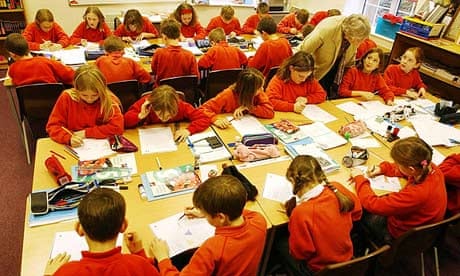The demographic strain on England's schools has been revealed by official statistics showing a sharp rise in the number of pupils being taught in packed primary classrooms.
The latest figures published in the annual school census reveal that 2,299 classes of five to seven-year-olds were above the government's guideline of 30 pupils per class in January this year.
That means that more than 4% of the 56,597 infant classes at key stage one were above the guidelines in the current academic year, compared with 2.7% at the same point in 2012.
The rise came as admissions to state-funded primary schools increased by nearly 100,000 on the year, while the number of primary schools in England fell slightly. The average key-stage-one class now has 27.3 pupils, compared with 27.2 in 2012 and 25.7 in 2008.
The Department for Education (DfE) said children were only permitted to join classes of 30 pupils in exceptional cases, and that classes usually fell back to 30 within a year or two.
The increase is largely the result of a demographic bulge caused by a mini-baby boom, after declining pupil numbers in the early 2000s. The situation is likely to get worse, with the National Audit Office forecasting that admissions will rise by another 240,000 in September this year.
The DfE said the government expected to add an extra 190,000 school places by the start of the new school year.
"We are spending £5bn by 2015 on creating new school places, more than double the amount spent by the previous government in the same time frame. We are also building free schools and letting the most popular schools expand to meet demand from parents," the DfE said.
The majority of super-sized classes were the result of successful appeals against school and local authority application decisions.

Comments (…)
Sign in or create your Guardian account to join the discussion